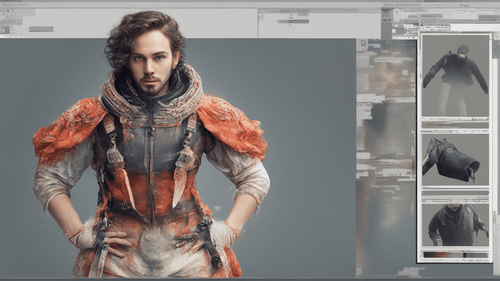
Introduction: The Evolution of Digital Art and Design
In the dynamic realm of digital art and design, innovations continue to reshape the boundaries of creativity. Among these revolutionary advancements, the concept of image to AI vector conversion stands out as a game-changer. This transformative process not only streamlines design workflows but also opens up new horizons for artists and illustrators. In this comprehensive article, we delve into the intricacies of image to AI vector conversion, exploring its nuances, benefits, challenges, and future prospects.
Understanding Image to AI Vector Conversion
Decoding Image to AI Vector Transformation
At its core, image to AI vector conversion involves the use of artificial intelligence algorithms to transform raster images into vector graphics. Raster images, composed of pixels, often lose quality and clarity when resized. Vector graphics, on the other hand, are based on mathematical formulas that define shapes, making them infinitely scalable without loss of quality. The marriage of AI and vectorization technology results in a process that automatically traces and converts pixel-based images into smooth, scalable vector art.
The Role of Machine Learning in Vectorization
Machine learning algorithms play a pivotal role in the accuracy and efficiency of image to AI vector conversion. Through exposure to extensive datasets, these algorithms learn to identify patterns, edges, and color gradients in raster images. As a result, they can make informed decisions during vectorization, replicating the details of the original image while optimizing it for various applications.
The Benefits of Image to AI Vector Conversion
Preservation of Image Quality and Detail
Traditionally, enlarging raster images led to pixelation and loss of detail. With image to AI vector conversion, this drawback becomes a thing of the past. AI-powered vectorization retains the intricate details of the original image, making it suitable for various outputs, from business cards to billboards.
Scalability without Compromise
Vector graphics are resolution-independent, which means they can be scaled up or down without any loss of quality. This scalability is a boon for designers, allowing them to create a single vector image that can be adapted for different platforms and dimensions.
Efficiency and Time Savings
Manual tracing of raster images to create vector graphics is a time-consuming process that demands meticulous attention. AI-powered vectorization accelerates this process, allowing designers to allocate their time to more creative tasks.
Versatility in Styling
Image to AI vector conversion doesn't just replicate the original image—it offers the flexibility to apply different styles and effects. Whether it's mimicking hand-drawn sketches or transforming a photograph into a stylized illustration, the AI-driven process adapts to the artist's vision.
Challenges and Limitations
Complex Compositions and Details
While AI algorithms have come a long way in recognizing intricate details, they can still face challenges when dealing with highly complex compositions. Images with numerous overlapping elements or intricate textures might require additional post-conversion adjustments.
Color and Gradient Interpretation
Interpreting color gradients accurately is another challenge for AI-driven vectorization. While advancements have been made, certain color transitions might not be seamlessly translated into vector form.
Balancing Realism and Simplification
AI vectorization often simplifies certain aspects of an image to achieve vector scalability. However, striking the right balance between maintaining realism and simplification is an ongoing consideration.
The Future of AI-Enabled Vectorization
Advancements in AI Algorithms
The field of artificial intelligence is evolving at a rapid pace, and vectorization algorithms are poised to benefit from these advancements. Enhanced pattern recognition, improved color interpretation, and better handling of complex compositions are some areas that are expected to see significant progress.
Integration with Design Software
As AI-powered vectorization becomes more sophisticated, integration with popular design software is on the horizon. This would empower designers to seamlessly switch between raster and vector formats, leveraging the strengths of both.
New Avenues for Creativity
The fusion of AI and vectorization opens doors to new realms of creativity. Artists and designers can experiment with styles and ideas that were previously constrained by technical limitations.
FAQs
Can AI accurately convert intricate hand-drawn sketches into vectors?
Yes, AI algorithms are increasingly adept at converting hand-drawn sketches into accurate vector representations. However, certain artistic nuances might still require manual adjustments.
Is image to AI vector conversion only suitable for digital art?
No, image to AI vector conversion has applications across various industries. It's commonly used in graphic design, illustration, logo creation, and even in converting technical drawings.
How does AI handle color interpretation during vectorization?
AI algorithms analyze color gradients and patterns in the original image to replicate them in vector form. While it's highly accurate, some color transitions might need minor adjustments.
Can AI-generated vector graphics be customized?
Absolutely, AI-generated vector graphics are versatile. Designers can modify styles, colors, and other attributes to align with their creative vision.
Are there any copyright considerations for AI-generated vector art?
Copyright considerations apply similarly to AI-generated vector art. It's important to ensure that the source material or images used as input are free from copyright restrictions.
Will AI vectorization replace manual vector tracing entirely?
While AI vectorization offers immense efficiency, manual vector tracing still holds value, especially for projects requiring a high degree of customization and human touch.
Conclusion: Transforming Design Landscapes with AI-Powered Vectorization
In the ever-evolving landscape of design and illustration, image to AI vector conversion emerges as a beacon of innovation. The fusion of AI algorithms and vectorization technology brings forth a new era of efficiency, scalability, and creative possibilities. As the boundaries of what's achievable continue to expand, designers and artists find themselves equipped with a powerful tool that not only simplifies their workflows but also enhances the very essence of their artistic expressions. With AI's relentless advancement, the journey of image to AI vector conversion is bound to be a captivating one, shaping the future of visual creativity.